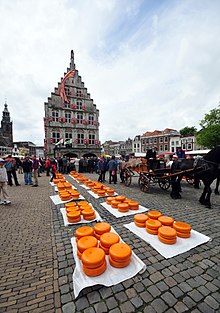Gouda cheese)
Gouda ( ndl. Goudse kaas ) is the name for various semi-hard cheeses that are produced based on the model of a cheese that traditionally comes from the Dutch city of Gouda . Today cheese is produced internationally under the name Gouda, while Gouda Holland has been registered and protected as a Protected Geographical Indication (PGI) since 2010 . There is also the Noord-Hollandse Gouda , which has been a product of protected origin since 1996 .
In the Netherlands, a distinction is made between Goudse boerenkaas (Gouda farmer's cheese), which is traditionally made on various farms, and the industrially produced Goudse kaas . Gouda is also produced industrially in Germany.
history
The Gouda originally comes from the cities of Stolwijk and Haastrecht , from the Krimpenerwaard region south of the city of the same name, Gouda , in the west of the Netherlands. It owes its name to the one from whose market the reputation of this cheese spread throughout the world. Gouda cheese was first mentioned in a document as early as 1184 . This makes Gouda one of the oldest cheeses that have been documented in writing and that have been produced and traded up to our time.

Gouda Holland has been registered as a Protected Geographical Indication (PGI) since 2010 and is thus protected under EU law of origin. Noord-Hollandse Gouda, on the other hand, has been registered as a protected designation of origin (PDO) since 1996 .
Manufacturing
When making cheese from Gouda, chilled milk from the previous evening is first mixed with fresh milk and heated to around 30 ° C. After the addition of rennet and lactic acid bacteria coagulate the milk within half an hour to curd . By continually cutting the curd into the curd with the help of a cheese harp and repeatedly skimming off the whey , liquid is removed from the curd until it has the desired consistency. It is then pressed into molds, which are typically round, and after a rest period in Lake bathed. It is then stored in cool maturing cellars for at least five weeks until the desired maturity.
Depending on the length of the ripening period, a distinction is made between young (four to eight weeks), middle-aged (two to six months) and old Gouda (usually six to eight months, sometimes longer, for example with Landana 1000 Dagen, which is over two years old ). Gouda that has matured for more than a year can also be found on the market under the names over- year or Gouda ancient . Such cheese then has an increasingly crystalline structure similar to Parmigiano Reggiano or Sbrinz and tastes extremely spicy, sometimes small grains of crystallized salts form. This cheese can then hardly be cut into thin slices; it is cut into thick slices as crumbled gouda and broken into small pieces for consumption. As Baby Gouda is called 3 weeks old cheese. This is also known as quick cheese . Called lunch cheese in Holland , in Germany it is also known as privy council cheese , Deichgrafenkäse or Deichhauptmannskäse .
Only 2 percent of the Gouda is made by hand - the majority is produced industrially. Industrial cheese often has no rind but matures in foil or in a wax coating. In addition, variants are occasionally produced with various flavoring additives such as spices, herbs, chilli etc.
taste
Young Gouda tastes creamy and mild, the cheese mass is soft to almost creamy and almost white to light yellow in color. Only after a longer ripening period does an increasingly strong, spicy taste develop. At the same time, the cheese becomes drier and darkens to an intense golden yellow. Annual Gouda tastes intensely spicy and slightly hot.
Another flavor that is differentiated in the trade is the Maigouda , which is made from the mildly aromatic milk that the cows give after they are fed on grass for the first time after the winter with silage on pastures outdoors - usually at the beginning of May . Like the milk from which it is made, maigouda has a slightly higher fat content and tastes particularly creamy and mild.
Further ingredients
Often additives are added to this cheese in order to achieve a better appearance or a longer shelf life.
- Colorants: Annatto (E 160b)
- Preservatives: Sodium Nitrate (E 251), Natamycin (E 235)
See also
Web links
Individual evidence
- ^ Website of Nieko Jongerius archive link ( Memento from February 7, 2008 in the Internet Archive )
- ^ Website of the CMA History of Cheese ( Memento of June 13, 2006 in the Internet Archive )
- ↑ Details on cheese worlds . Retrieved June 17, 2014.
- ↑ Entry in the EU database DOOR , accessed on January 25, 2019.



